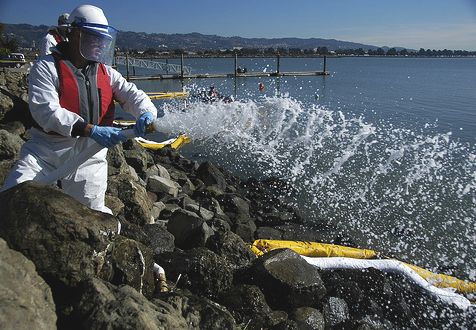
NOAAA worker spraying Corexit in the Gulf.
Should the federal government regulate where oil dispersants can be used and how much can be dumped into waterways following oil spills?
“Nah,” says the EPA.
Environmental groups filed suit last year seeking to force the agency to improve its oversight of the use of dispersants. But a federal judge this week tossed out the lawsuit after oil industry attorneys helped EPA win on a technicality.
Americans woke up to the dangers of oil dispersants after BP poured more than 1.8 million gallons of Corexit EC9500A and Corexit EC9527A into the Gulf of Mexico following the Deepwater Horizon blowout. The toxic dispersants helped the crude oil mix with water, forcing it down from the surface and into the water column, out of sight of humans and television crews but into the habitat of a lot of marine wildlife. The chemicals also made cleanup workers and local residents horrifically sick.
It was nearly 30 years ago, in 1984, that the EPA finalized its rules for dealing with dispersants and began compiling a schedule of chemicals that may be used to control oil spills. The Sierra Club and the seven other environmental groups behind the suit called for the agency to expand its plans to include details on the places and the quantities in which the chemicals can be used. The EPA said it prefers giving the oil industry flexibility to battle spills based on local conditions.
The groups claimed the EPA’s failure to include information about water bodies and safe chemical quantities violated its statutory duties under the Clean Water Act.
They claimed the EPA “acted arbitrarily and capriciously” each time it added a new chemical to the product schedule in the past 6 years.
The EPA and intervenor-defendant American Petroleum Institute (API) sought dismissal, arguing that the groups’ claims were untimely because they sued 30 years after the EPA published the contingency plan and product schedule.
[U.S. District Judge John] Bates sided with the EPA, agreeing that the environmental groups did not present their claims by the statutory deadline.
“… the court concludes that the time for bringing suit has long since passed and hence plaintiffs’ claims must be dismissed.”
Congratulations on the victory, EPA. If only you focused as hard on protecting Americans from dispersant-spraying oil companies as you do on crafting legal arguments.




